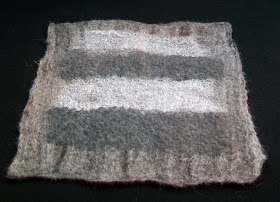The grey Norwegian felted really nicely, the wave and crimp of the wool re-appeared after felting and it pulled on the milk protein fibre, which was already waving from being pulled by the shrinking felt. It gave that an interesting texture too, and made it more rippley.
Pages
▼
Saturday, 24 March 2012
Natural Wools and Fibres (2)
A couple of other Natural wool and fibre combinations I've tried recently are grey Suffolk and Banana fibre, and grey Norwegian and Milk protein fibre. Grey Suffolk is a coarse wool and the felt it makes is kind of loose or spongey. Although the banana did felt onto the Suffolk somewhat, it wasn’t firmly attached and gave interesting cobweb like results. It reminded me of the photos of fields and trees that are covered in webs after flooding.
The grey Norwegian felted really nicely, the wave and crimp of the wool re-appeared after felting and it pulled on the milk protein fibre, which was already waving from being pulled by the shrinking felt. It gave that an interesting texture too, and made it more rippley.
The grey Norwegian felted really nicely, the wave and crimp of the wool re-appeared after felting and it pulled on the milk protein fibre, which was already waving from being pulled by the shrinking felt. It gave that an interesting texture too, and made it more rippley.
Sunday, 11 March 2012
Natural wools and fibres
I've been trying out different natural coloured wools with different natural fibres over the past few months. By 'natural' fibres, I mean plant based like bamboo, corn, soybean, hemp etc, though there have also been a few trials with leaves and stuff from the garden :)
Flax looks and feels just like dried plant material before felting, but after felting is a lot softer and shiny. This is a before and after felting picture of flax wet felted with natural brown merino tops:
Another combination I tried was Black Jacob tops and natural Soybean tops. As the felt was drying the soybean looked a gorgeous shiny golden colour:
One of my favourites lately was Oatmeal Bluefaced Leicester with Ingeo top, I covered the whole piece with Ingeo tops. This was another piece that really shined in the dim light as it was drying. Here's a half and half picture of drying and dry:
Do you have any favourite combinations of natural wools and natural fibres? It's really interesting seeing how a fibre can look very different depending on which wool it's used with.
If you'd like to see more/bigger versions of the photos, have a look on the Felting and Fiber Studio site.
This post features the Flax and Soybean pieces, and this post features the Ingeo and Bamboo. If you click 'permalink' under the photos in the gallery, you get proper sized photos.
Flax looks and feels just like dried plant material before felting, but after felting is a lot softer and shiny. This is a before and after felting picture of flax wet felted with natural brown merino tops:
Another combination I tried was Black Jacob tops and natural Soybean tops. As the felt was drying the soybean looked a gorgeous shiny golden colour:
One of my favourites lately was Oatmeal Bluefaced Leicester with Ingeo top, I covered the whole piece with Ingeo tops. This was another piece that really shined in the dim light as it was drying. Here's a half and half picture of drying and dry:
Humbug Jacob Tops is a blend of black and white Jacob fleece that gives a subtle stripey effect, I used strips of black and white bamboo with this. Black bamboo is very matt, and white bamboo is very shiny.
Do you have any favourite combinations of natural wools and natural fibres? It's really interesting seeing how a fibre can look very different depending on which wool it's used with.
If you'd like to see more/bigger versions of the photos, have a look on the Felting and Fiber Studio site.
This post features the Flax and Soybean pieces, and this post features the Ingeo and Bamboo. If you click 'permalink' under the photos in the gallery, you get proper sized photos.

.JPG)
.JPG)


.JPG)



